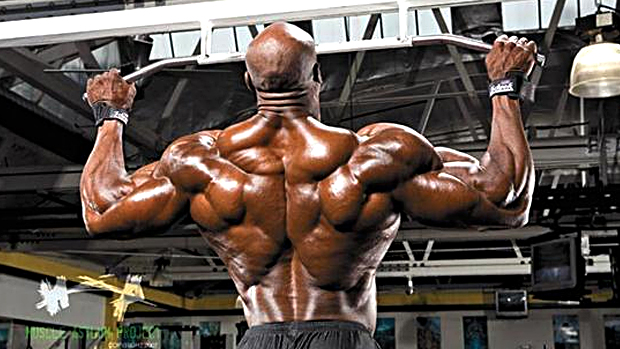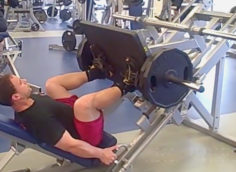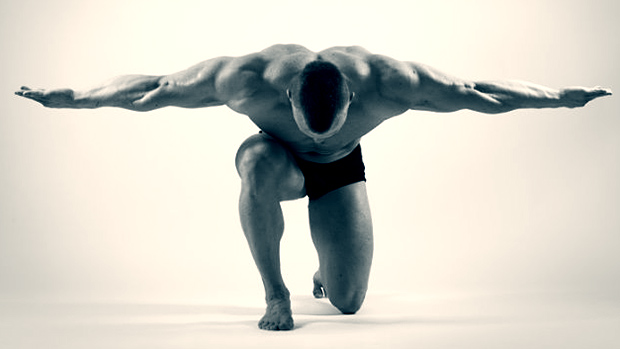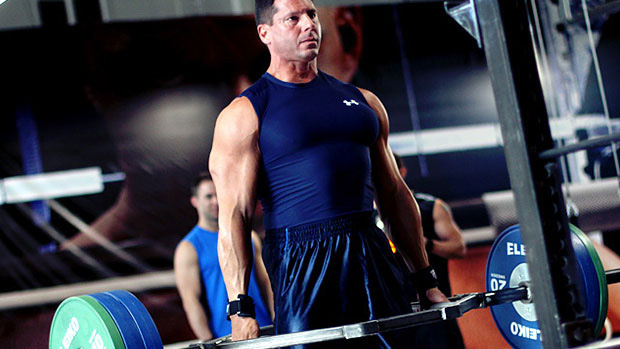Last time, I debunked some of the myths about squats and deadlifts that a group of often-quoted but totally bogus individuals (sometimes known as "they") have been passing off as truth. This time, I'll take a crack at a few misconceptions concerning upper body exercises.
BENCH PRESS
Misconception #5:
"They say to keep your lower back on the bench."
For some reason, many trainees think they need to try to keep their lumbar spine (lower back) flat on the bench when they perform any kind of bench press. My first question to these folks is simply, why? Their response is often, "Because I don't want to hurt my lower back." Why on earth would anyone think that keeping their lumbar spine completely pressed against the bench would keep their back "safe" while you're bench pressing? I challenge anyone to show me how arching your back while bench pressing places any added stress on the lower spine.
I believe that many people simply confuse the (correct) advice of keeping your butt on the bench with the bogus advice of keeping the lumbar spine on the bench. You need to keep your spinal column locked and your shoulder blades retracted and depressed.
This will entail having a curve in your lumbar spine. You don't need to press your lumbar spine into the bench as you perform a bench press, but you do need to keep your butt on the bench or you're changing the movement into an unsupported decline bench press, which is not a good idea.
 |
The only time you should thrust your hips up like this is when you're having sex on the bench.
Allowing your butt to come off the bench also kills your stability. You want to have maximal stability if you want to maximize the loads that you use. No cannons from canoes, remember? All you need to do is simply maintain the normal curve of your low back as you bench press. For general training purposes, you don't need to excessively arch the lower back, but as long as you don't have any preexisting back problems, a big arch is generally not a problem.
Misconception #6:
"They say that putting your feet in the air will isolate the pecs more"
Okay, let's put this dog quickly and painlessly to sleep. We've all seen it, right? The goofballs that stick their feet in the air, pull their knees up to their chest, or put their feet on the bench, as the bar wobbles and the plates jingle. First off, I don't need to explain that you can'tisolate a muscle, right? Second, how does putting your feet up in the air like a dead cockroach transfer stress from the other pressing muscles onto your pecs, for Pete's sake?
I'll answer that. It doesn't, so stop doing it! All you do is lose stability and limit the loads you can use, as we mentioned above. You need lateral stability from your legs when you bench press. Lifting your legs off the floor while you're lying on a bench makes zero sense, and only makes the movement dangerous.
 |
If this doofus thinks his "dead cockroach press" is isolating his pecs, he's wrong.
ROWS
Misconception #7:
"They say to pull the bar (dumbbell, handle, etc.) back as far as you can on row variations."
This is a very common error that just aggravates shoulder problems in many people. Indianapolis Physical Therapist and Strength Coach Bill Hartman got me to really focus on this with my clients. When you simply try to pull the implement back as far as you can with your hand, you will frequently lose your scapular stability. This will often look like one is performing an upward shrug with the shoulders (scapular elevation). This motion will cause the glenohumeral joint to be hyperextended (the upper arm moves way past the plane of the torso) and pushes the humeral head forward.
 |
The glenohumeral joint, frequently the victim of overzealous rowing.
Bill explains, "If the posterior shoulder capsule is stiff or short and/or the anterior capsule is loose or the subscapularis fatigues or fails to restrict the forward movement of the humeral head, impingement will follow. Many people have trouble with this because of a stiff short pectoralis minor or thoracic kyphosis. The humerus should stop moving when the scapula stops. This prevents excessive shoulder extension and wear and tear on the anterior structures."
 |
Thoracic kyphosis (on right).
This can typically be viewed from the side when the upper arm is in line with or a tad behind the line of the torso. A trick that Bill shared with me is to have clients perform the movement in two steps in the early stages of learning a rowing type movement. The first step is to retract and depress the scapula (keep arms extended), and the second step is to extend the humerus. This effectively blocks the hyperextension of the upper arm if you concentrate on maintaining the scapular position. You would then move into integrating this into one smooth motion as a progression in programming.
 |
Shoulder hyperextension: bad.
 |
Correct finish position: scapula fully retracted and depressed. Note the position of the upper arm in relation to the torso in both pictures.
PULL-UPS/CHIN-UPS
Misconception #8:
"They say pull-ups work your lats more than chin-ups because they minimize the use of your biceps. They're also harder so they must be better."
I can hear the whistle of incoming flames already. Some of you are probably thinking, "Surely this can't be a misconception." Well, just hang in there (pun intended) and hear me out. Others may be scratching their heads and saying, "But aren't pull-ups and chins just different names for the same exercise?" No, they're not. Let's once again define our terms. When you do pull-ups, your hands are pronated (palms facing away from the body when placed on the bar), and you typically grip the bar a bit wider than shoulder width.
When you do chin-ups, your hands are supinated (palms facing towards the body when placed on the bar) and you grip the bar right around shoulder width, or a bit narrower or wider depending on individual comfort.
 |
This is a chin-up.
Most people find that chin-ups are easier because you're better able to use your biceps, and pull-ups are harder because you can't use your biceps as much. They likely deduce that because of this, pull-ups allow you to put more stress on the lats, and therefore are better for lat development. It's an understandable conclusion, but it's wrong.
In the chin-up, the biceps are placed in a much more efficient pulling position. This enables one to do more reps, or use more weight, as compared to the pull-up, which places the biceps in a comparatively weaker pulling position. If we are trying to get maximal development of the lats, we want to maximize the loading (and loading duration) of the involved musculature by placing the smallest muscles in a position where they can last the longest or be loaded the greatest so that they don't give out prior to the larger muscles involved. Chin-ups accomplish this. Pull-ups don't.
Make no mistake about it, in the pull-up the elbow still flexes, and the movement will be over when the elbow can no longer flex. In addition, the lat contracts through a greater range of motion at the glenohumeral joint on the chin-up. Generally, it's always better to take a muscle through its full safe range of motion for optimal development.
Many times, though, trainees will become concerned with where they "feel" the exercise and they imagine they "feel" the pull-up more in the lats and feel chin-ups more in the biceps. However, unless you have some crazy strength imbalance and can curl your bodyweight, you don't need to worry about feeling chin-ups in your biceps.
By the way, about that upper back "pump" you think you're feeling in your lats after a set of pull-ups: what you're actually feeling is the teres major (a.k.a the "mini-lat"), a relatively small muscle that's being recruited more in the pull-up variation because of the greater adduction component at the shoulder.
 |
That "lat pump" you feel after doing pullups is actually the little teres major.
I'm not suggesting that the pull-up isn't a viable alternative to chins on occasion, but I do believe that if you're using them to maximally develop your lats because you think your biceps aren't involved as much, you need to re-examine your approach.
Chins are probably a better option because you can increase the duration of loading on the lats and use more load in comparison along with an increase in the range of motion. The arm development from chins is a nice side benefit as well, which I'm sure many wouldn't complain about.
Wrapping Up
That's it! Hopefully, I have cleared up some things that have caused some confusion for many and this article will lead to new progress in your lifting and coaching, and at the very least given you some ammunition to fire back at people who mindlessly repeat whatever "they" say.
Craig Rasmussen, CSCS is a performance coach at Results Fitness in Newhall, California. He's a competitive powerlifter, and has worked with a wide variety of clients and athletes.
References:
- Hartman, B. Personal communication. August, 2007
- Photos courtesy of Bill Hartman





